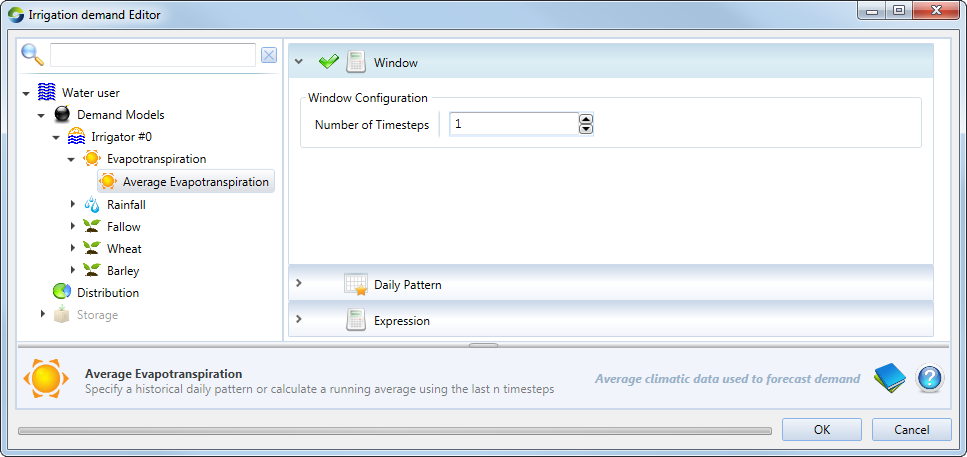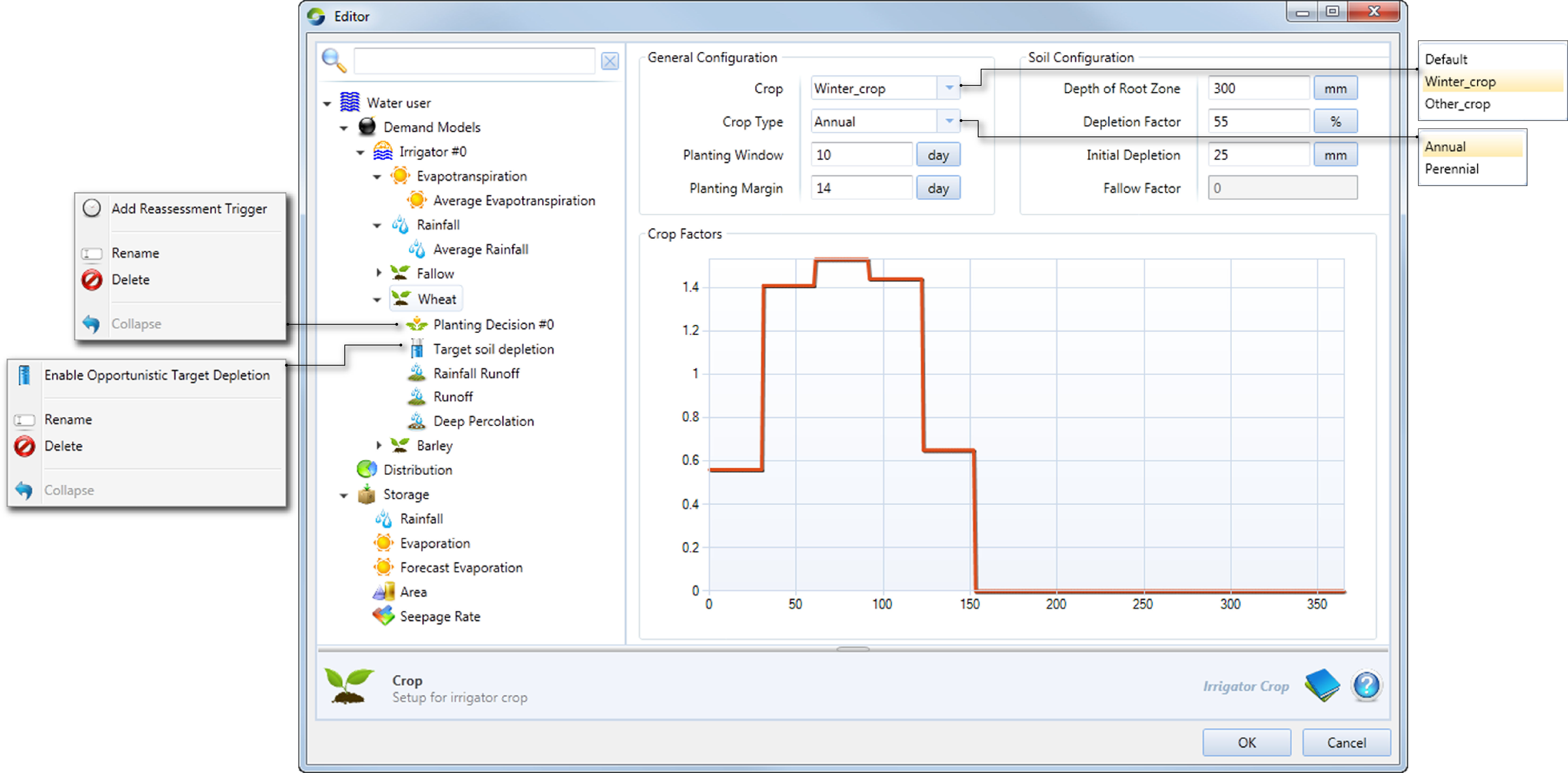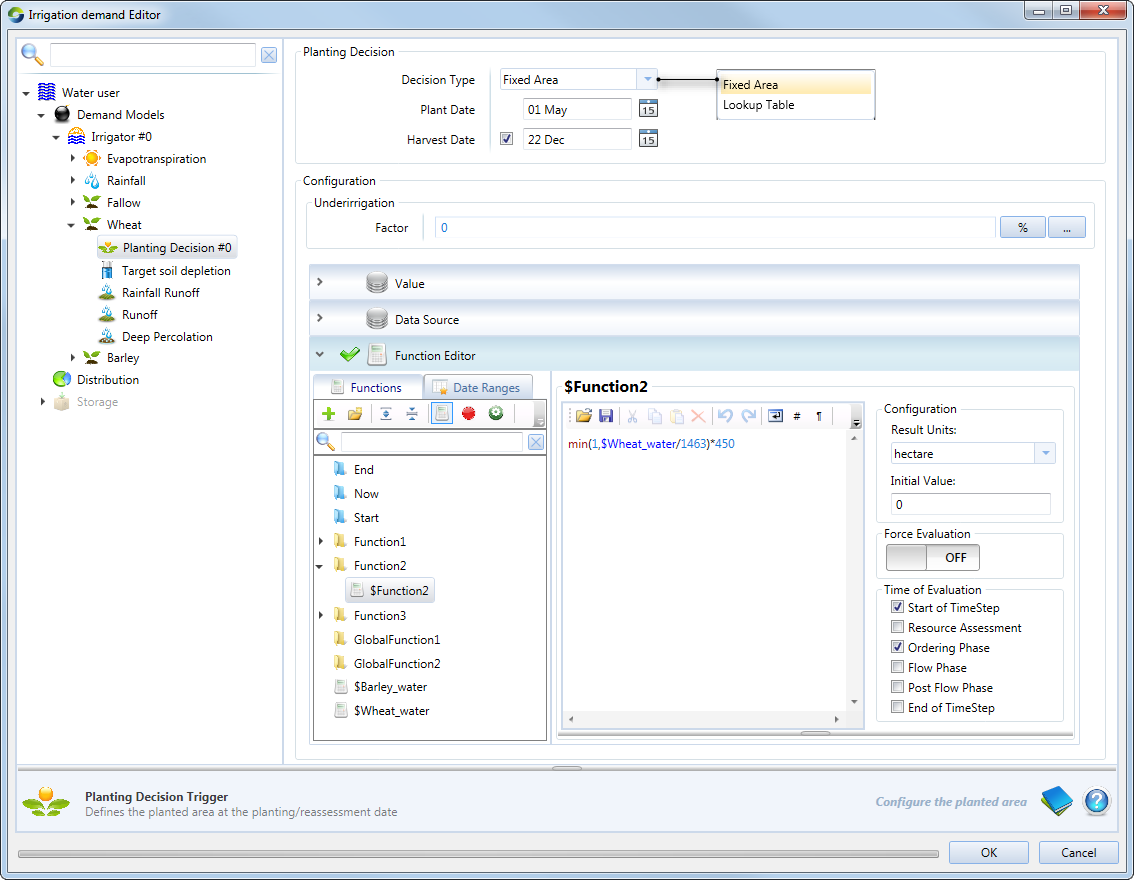Irrigator operates on a daily basis generating demands and extracting water to meet these demands via the water user and supply nodes. Irrigator maintains a daily water balance for each cropping area during its planting season to calculate the daily soil water deficit and an irrigation requirement. The irrigation requirements are used by the Water User to generate orders and opportunistic requests and to subsequently place orders and requests and to extract water from a water source.The model can be applied in both regulated and unregulated systems.
Configuring generic crop settings
The Irrigator model is based on FAO56 - "Crop evapotranspiration - Guidelines for computing crop water requirements - FAO Irrigation and drainage paper 56: (http://www.fao.org/docrep/X0490E/X0490E00.htm). Before configuring an Irrigator Demand Model on a Water User node, you must specify crop factors for the entire scenario using Crop factors defined in this way are accessible for each water user node. More details regarding this can be found at IQQM CropMod2 Demand Model.
To configure an irrigator demand model in Source, right click Demand Models in the Water User node's feature editor and choose Add Irrigator (Figure 1).
District Configuration
This describes a number of parameters that can be set at an irrigation district level. The following parameters must be configured:
- Maximum irrigated area - this represents the maximum area that can be irrigated within a district. It is used to calculate the fallow area at each time-step, which impacts on the rainfall runoff from the fallow area. The total irrigated area can exceed the maximum irrigated area if incorrectly configured, causing a warning message to be recorded at run time;
- Soil moisture capacity - this is assumed constant for all crops in the district. Soil moisture capacity is nominally the difference between the soils field capacity and permanent wilting point; and
- Irrigation start and end dates - if these are configured, orders and requests will only be generated within the irrigation season.
Figure 1. Irrigator demand model
Climate Configuration
There are four parameters that can be defined for climatic data:
- Evapotranspiration - defined in FAO56 as the amount of transpiration that would occur from a reference crop. Procedures for calculating evapotranspiration are documented in FAO56. In addition, the BOM and SILO climate products produce daily estimates for FAO56. Alternatively, pan evapotranspiration and pan factors can be used to define evapotranspiration;
- Average evapotranspiration (Figure 3) - used when forecasting orders. Two options are provided for specifying the average evapotranspiration. You can enter a daily pattern of average evapotranspiration, or you can select to calculate an average evapotranspiration runtime, where the average is calculated as a rolling average of the number of previous model time-steps specified. A value of 14 days would be a good first estimate; and
- Rainfall and average rainfall are used to specify the actual forecast rainfall.
Figure 2. Irrigator demand model (Climatic parameters)
Figure 3. Irrigator demand model (Average evapotranspiration)
Fallow Crop
Areas that are not being cropped are referred to as fallow. Every irrigator demand model has, by default, one fallow area. Fallow area occurs between cropping seasons or during the irrigation season if the maximum developed area is not planted. The fallow cropping area does not order or receive irrigation water. However, a soil water balance of the fallow crop is maintained, and impacts on rainfall runoff from the fallow area and the initial souild moisture assigned to new crops area. The depth of rootzone for fallow represents the depth of soil from which evaporation can occur.
Crop Configuration
This is used to define parameters specifically related to the crop to be planted. To add a new crop, right click Irrigator and choose Add Crop Type. Figure 4 shows an example of a crop, named Wheat, that has been added to the model. Consult the Source Scientific Reference Guide for greater detail regarding parameters for the following sections.
Figure 4. Irrigator demand model (General and Soil Configurations)
Soil Configuration
Crop specific soil factors can be defined on the same page as General Configuration - see Figure 4. Soil moisture capacity is specified at the district level and this is assumed constant for all crops in the district. The Depth of the Root Zone, Depletion Factor and Initial Depletion are specified for each crop.
Planting Decision
Planting decisions are represented as a trigger in the Irrigator Demand Model and include a decision type, plant date, optional harvest date and an under irrigation factor.The number and size of cropped areas changes over time in response to planting decision triggers and available water.
Figure 4. Irrigator demand model (Planting Decision Trigger)
Target soil depletion
The amount of water in the rootzone is defined in terms of rootzone depletion, which describes the soil water deficit of the rootzone relative to field capacity. The target depletion can be specified as a time series, a pattern or as an expression.
Two target depletions can be specified (as shown in Figure 4):
- A Regulated Target - the target at which Irrigators water and attempts to maintain soil depletion; or
- An Opportunistic Target - used to generate opportunistic requests.
Economics
Some simple, economic considerations are provided in Irrigator. To enable economic values to be configured for a crop, right click on the crop and choose Enable Economics. A simple, linear crop water production function is used to predict the reduction in crop yield resulting from water stress. Irrigator records the relative yield as a daily time series. The Yield factor represents the Yield response factor, as expressed in equation 90 of FAO56. Note that in Irrigation, the yield response factor is entered as a percentage rather than as a fraction. The Expected Usage is a depth, and thus entered in mm (note that 100mm is equivalent to 1ML/ha). Productivity allows you to multiply the relative yield by a productivity term (eg. $/ha or tonnes/ha) to calculate socio-economic outputs.
For more information consult the /wiki/spaces/SD35/pages/57872388 page of the Source Scientific Reference Guide.
Figure 5 - Irrigation demand model (Crop Economics)
Runoff
The supply escape efficiency defines the amount of applied irrigation water that becomes runoff. A value of 0 results in no irrigation runoff, 10% indicates that 10% of the applied irrigation water becomes runoff. You must also specify a return efficiency, which means that the proportion of runoff that is returned to the water user can be stored in the farm storage or returned to the river. By default, both are set to 0, and do not need to be configured.
Crop Deep Percolation
This specifies the percentage of applied irrigation and rainfall that becomes deep percolation and drains below the rootzone. A 10% supply escape efficiency would indicate that 10% of the applied water becomes runoff. The return efficiency is not configurable for deep percolation.
Target Modifier
Irrigation modifiers are included in Source to allow a simple mechanism to reduce irrigation intensity for recurring time periods. To enable a target modifier, right click on the crop type, choose Add Target Modifier. This provides equivalent functionality to demand reductions in the PRIDE model. By specifying a target modifier, a new soil depletion target is calculated during the specified period that results in a reduction in irrigation demand equivalent to the modifier you specified.
District Supply Escape
The district requirement is adjusted to allow for any district delivery supply escapes and losses associated with delivering water to the district. The volume removed before getting to the crop is called the escape volume. The escape volume can either be lost from the system or returned back to the water user as a return flow. This is an optional parameter in the demand model and can be added by right clicking Irrigator, then choosing Supply Escape. It is expressed as a percentage.
District Return Efficiency
Returned water is surplus drainage water from irrigation or from rainfall runoff. This water can be redirected into the on farm storage or otherwise can be returned to the river via a confluence node. This is optional in the demand model configuration and can be added by right clicking Irrigator and choosing Return Efficiency. This is also expressed as a percentage.





